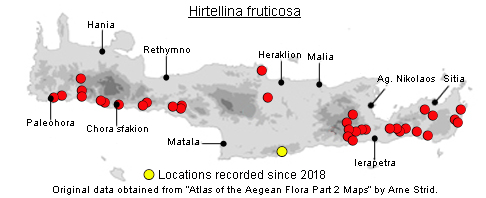SPECIES DESCRIPTION
HIRTELLINA FRUTICOSA
Family:- COMPOSITAE
Common Names:- None
Synonyms:- Staehelina fruticosa
Meaning:- Hirtellina (L) Slightly hairy.
Fruticosa (L) Of shrub-like habit.
General description:- Small tufted shrubs.
Stems:- Up to 150 cm, the branches furnished with small glands or covered in soft
fine hairs, with rosettes of leaves at the apices.
Leaves:- 35-55 x 8-15 mm, lance-shaped, acute, subpungent, entire, hairless
(glabrous), sea-green covered with a bloom (glaucescent) , stalkless (sessile) or
short stalked; rosette-leaves oblong-spatula-shaped, obtuse.
.
Flowers:- Capitula short and broad, more or less flat-topped indeterminate flower
cluster, the outer flowers opening first; involucre 10-12 x 4-5 mm; involucral bracts
acute, hairless, light brown, the lower green at apex. Corolla whitish.
Fruit:- Achenes 5-6 x 1-1·5 mm, white-villous; pappus 10-12 mm.
Key features:-
1) Leaves glabrous.
2) Ovary and achenes covered with long, white shaggy hairs (villous).
Habitat:- Crevices of limestone cliffs, generally, in semi-shade and usually near the
sea, occasionally to 1200 m.
Distribution:- Endemic S and SE Aegean area. Limited distribution on Crete
mainly in the southeast and southwest. Rare.
Flowering time:- Late Aug to Oct.
Photos by:- Steve Lenton
FAMILY AND GENUS DESCRIPTIONS
COMPOSITAE
General description:- Herbs or shrubs.
Leaves:- Alternate, opposite or arranged in a rosette (rosulate), exstipulate.
Flowers:- Small (florets), hermaphrodite, functionally male, female, or sterile, in
terminal or axillary, usually stalked (pedunculate) capitula, surrounded by an
involucre of bracts. Capitula solitary or in corymbose, less frequently racemose,
inflorescences. Calyx-limb (pappus) absent or represented by a corona, auricle,
scales, stiff hairs (setae) or simple or softly feathered (plumose) hairs. Corolla of 3
main types: (a) tubular, with (3-)4- to 5-lobed limb, actinomorphic or rarely weakly
zygomorphic; (b) tubular, with a 2-lipped limb; (c) ligulate, with a short tube and the
limb prolonged on one side into a usually 3- or 5-toothed ligule; female florets
sometimes without a corolla or with a thread-like (filiform) corolla. Stamens 5,
united with the petals (epipetalous); anthers usually united (connate) into a tube
round the style, often abruptly ending in a long tail-like or appendage tip (caudate)
or arrowhead-shaped (sagittate) at base and with apical appendages. Ovary inferior,
single-celled (1-locular); ovule solitary, basal, bent parallel to its stalk so the
micropyle is close to the point of funiculus attachment (anatropous); style solitary,
with 2 stigmatic branches.
Fruit:- A cypsela (achene).
The length of the involucre is measured from the base of the capitulum. Pappus-
hairs are described as plumose when the length of the branches is at least 3 times
the diameter of the main hair but much shorter than it.
HIRTELLINA - STAEHELINA
General description:- Small tufted (caespitose) shrubs.
Leaves:- Alternate, often crowded in rosettes near apices of branches, entire or
with 3 or more lobes (pinnatifid), divisions extending from about a quarter to half-
way towards the midrib, leathery (coriaceous).
Flowers:- Capitula in terminal corymbose cymes, rarely solitary. Involucre more or
less cylindrical; bracts overlapping (imbricate), unequal, oblong to ovate, ending
abruptly in a sharp point (mucronate). Receptacular scales narrow, split into many
lobes (multifid). Florets all hermaphrodite. Corolla pink to purple, tubular, 5-fid.
Fruit:- Achenes oblong, more or less ribbed (costate), brown; pappus of one row of
white hairs with branches about as long as the hair.
Key features:-
1) Leaves unarmed.
2) Pappus-hairs with branches about as long as the hair.
3) Achenes oblong, ± ribbed.
Status:-
Conservation status (for threatened species): Rare (R) according to IUCN 1997
Protection status (for threatened species): Greek Presidential Decree 67/1981
